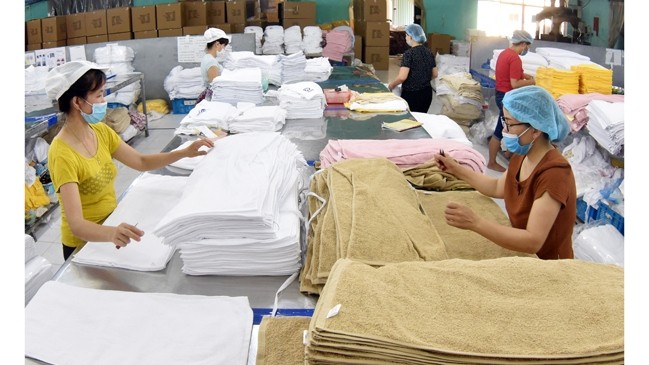Positive signals
Since the beginning of 2020, the COVID-19 outbreak in China has disrupted many trade activities between Vietnam and its biggest export market, especially in regards to agricultural and aquatic products, as well as the import of raw materials for domestic production.
However, export activities have only really been affected since the second quarter after the epidemic had spread globally, including in Vietnam’s major trading partners such as the US, the EU, Japan, ASEAN, etc. The fact that many countries have simultaneously taken strict measures to prevent the spread of the epidemic such as travel restrictions and the closing of restaurants, borders and airports have all disrupted the global trade chain.
According to the Import-Export Department under the Ministry of Industry and Trade (MoIT), the country’s export revenue in the second quarter was estimated at US$57.98 billion, down 8.3% compared to the first quarter and 9% lower than the same period in 2019. In the first six months, total export revenue was estimated at US$121.2 billion, down 1.1% over the same period last year.
One good sign is that Vietnam has been able to control the epidemic in the country, whilst European countries and the US have gradually reopened since the end of April, helping production and export activities recover quite quickly.
Specifically, total export revenue, after plummeting to US$17.58 billion in April, increased by 9.1% in May and continued to increase by 9.5% in June. Export revenue also gradually narrowed the gap compared to figures from before the outbreak of the COVID-19 epidemic (in May revenue decreased by 12.3% over the same period but in June only decreased by 2%).
In particular, export results of domestic enterprises have shown better resilience to the impacts of the epidemic. Specifically, in the past six months, the export revenue of these enterprises increased by 11.7%. This result shows that the growth motivation of domestic enterprises no longer depends on the export growth of agricultural and aquatic products as in previous years. This trend started over the last few years, especially since 2019 as the export of agricultural and aquatic products was in trouble, the export of the domestic sector remained high and even higher than the country's overall growth.
On June 8, the National Assembly of Vietnam officially approved the EU - Vietnam Free Trade Agreement (EVFTA) and the EU - Vietnam Investment Protection Agreement (EVIPA). The EVFTA is scheduled to take effect in August, opening great opportunities for Vietnam to access the world's second largest import market with a population of more than 508 million and a GDP of about US$18 trillion. When the EVFTA is put into effect, Vietnamese enterprises will see great advantages from the reduction/elimination of tariff barriers and the potential to seize export opportunities in the EU market.
Proactively facing challenges
The COVID-19 epidemic is still complicated in many countries, with great potential risks. Even more concerns have started to reappear in Asia as some countries are facing the risk of a large second wave.
In China, as the epidemic showed signs of rebound, the country immediately applied many measures to limit the spread of the COVID-19. Specifically, the government and a number of localities in China have intensified checking the origin and quality of food products.
At the same time, the government of Guangxi province, which shares a border line with Mong Cai city, Quang Ninh province, is also strictly managing goods at markets and supermarkets; strengthening the inspection of documents such as certifications of quality standards, certificates of origin and purchase vouchers for agricultural products, etc. This will inevitably cause additional barriers to goods from Vietnam, especially agricultural and aquatic products.
The MoIT has recommended that enterprises and households producing agricultural and aquatic products for export to China should strengthen quality supervision, proactively coordinate with importers to strictly comply with regulations on quality standards, food safety, and origin. At the same time, enterprises need to actively monitor and update market information in order to actively bring goods to border gates, thereby reducing risk and time needed for goods clearance at border gates.
The MoIT will actively coordinate with the Ministry of Finance and relevant agencies to continue to ensure customs clearance, promptly remove difficulties and problems in goods export activities and coordinate and support border provinces to facilitate the goods clearance process.
On the other hand, in order to support export activities in the last months of the year, the MoIT will continue to focus on improving the efficiency of trade promotion, especially in the application of online trade promotion to maintaining markets, connecting trade between Vietnamese businesses and partners wishing to import in markets capable of early recovery and then gradually expanding to other markets according to their epidemic developments.
More attention should also be paid to actively exploit the opportunities presented by the Free Trade Agreements, diversifying export markets and finding new markets, being especially ready to carefully prepare the necessary conditions, proactively implement plans and solutions to export goods to the EU market after the EVFTA takes effect.
















